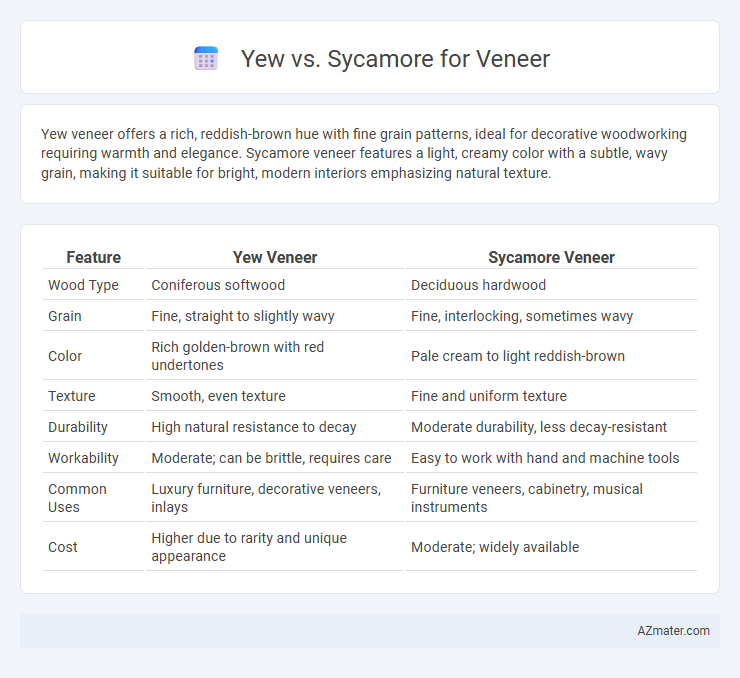Yew veneer offers a rich, reddish-brown hue with fine grain patterns, ideal for decorative woodworking requiring warmth and elegance. Sycamore veneer features a light, creamy color with a subtle, wavy grain, making it suitable for bright, modern interiors emphasizing natural texture.
Table of Comparison
| Feature | Yew Veneer | Sycamore Veneer |
|---|---|---|
| Wood Type | Coniferous softwood | Deciduous hardwood |
| Grain | Fine, straight to slightly wavy | Fine, interlocking, sometimes wavy |
| Color | Rich golden-brown with red undertones | Pale cream to light reddish-brown |
| Texture | Smooth, even texture | Fine and uniform texture |
| Durability | High natural resistance to decay | Moderate durability, less decay-resistant |
| Workability | Moderate; can be brittle, requires care | Easy to work with hand and machine tools |
| Common Uses | Luxury furniture, decorative veneers, inlays | Furniture veneers, cabinetry, musical instruments |
| Cost | Higher due to rarity and unique appearance | Moderate; widely available |
Introduction to Yew and Sycamore Veneers
Yew veneer offers a rich, warm hue with distinctive grain patterns prized for fine woodworking and decorative panels, showcasing durability and a unique aesthetic often sought in traditional and luxury interiors. Sycamore veneer features a lighter, creamy color with subtle figuring that highlights its smooth texture and versatility, making it ideal for modern furniture and cabinetry. Both veneers provide excellent workability and finishing qualities, but differ significantly in color tone and grain character, influencing design preference and application.
Botanical Overview: Yew vs Sycamore
Yew (Taxus baccata) is an evergreen coniferous tree with dense, fine-grained wood prized for its rich reddish-brown color and uniform texture, making it ideal for detailed veneer work. Sycamore (Acer pseudoplatanus), a deciduous hardwood, features pale, creamy white sapwood with interlocking grain patterns, offering a striking contrast and durability for veneer applications. The botanical differences between Yew's slow growth and resinous heartwood versus Sycamore's rapid growth and lighter, more porous wood directly influence veneer aesthetics, workability, and strength.
Grain Patterns and Visual Appeal
Yew veneer features a tight, straight grain with fine texture, offering a warm golden hue that enhances intricate woodworking details. Sycamore veneer displays a more varied grain pattern, often with wavy or curly figuring, creating dynamic visual interest and a lighter, creamy color palette. Both woods are prized for their unique aesthetics, but Yew's uniform grain suits traditional elegance while Sycamore's striking patterns complement modern, artistic designs.
Durability and Longevity Comparison
Yew veneer offers exceptional durability due to its dense, fine-grained structure, making it highly resistant to wear and impact compared to sycamore veneer, which is softer and more prone to dents and scratches. Sycamore veneer, while visually appealing with its light color and subtle grain, lacks the longevity of yew and may require more frequent maintenance or replacement in high-traffic applications. For projects where long-term resilience is critical, yew veneer provides superior performance, ensuring sustained structural integrity and aesthetic appeal over time.
Workability and Machinability
Yew veneer offers excellent workability due to its fine, even grain and moderate hardness, allowing for smooth cutting and shaping with minimal tear-out. Sycamore veneer is known for its uniform texture and consistent density, which contributes to superior machinability and ease of sanding, making it ideal for intricate detailing. Both veneers respond well to adhesives and finishes, but yew's natural oils may require surface preparation for optimal bonding.
Cost and Availability of Veneers
Yew veneer is typically more expensive due to limited availability and slower growth rates, making it a rarer choice for fine woodworking projects. Sycamore veneer offers greater availability and affordability, as sycamore trees grow more quickly and are widely harvested. The cost difference between yew and sycamore veneers can be significant, with sycamore providing a more budget-friendly option without sacrificing visual appeal.
Environmental and Sustainability Factors
Yew wood, known for its slow growth, offers a dense and durable veneer but raises sustainability concerns due to limited natural regeneration and the risk of overharvesting in its native habitats. Sycamore, a fast-growing hardwood with abundant availability, presents a more sustainable option for veneer production thanks to its higher yield per acre and lower ecological impact. Choosing sycamore supports responsible forestry practices and reduces the carbon footprint associated with sourcing rare timber like yew.
Popular Applications in Interior Design
Yew veneer is prized for its rich, reddish-brown hue and fine grain, making it ideal for luxury furniture and decorative paneling in interior design. Sycamore veneer offers a lighter, creamy tone with subtle grain patterns, commonly utilized in modern cabinetry and wall coverings to create a bright, spacious feel. Both veneers enhance aesthetic appeal, but Yew is favored for traditional, high-end finishes, while Sycamore suits contemporary, minimalist interiors.
Maintenance and Care Considerations
Yew veneer requires careful maintenance due to its soft texture, making it susceptible to dents and scratches, necessitating gentle cleaning with a soft cloth and avoidance of harsh chemicals. Sycamore veneer is more durable and resistant to wear, tolerating regular dusting and occasional polishing with mild wood cleaners for optimal preservation. Both veneers benefit from controlled humidity and protection from direct sunlight to prevent warping and discoloration over time.
Choosing the Right Veneer for Your Project
Selecting the right veneer involves understanding the distinct characteristics of Yew and Sycamore. Yew veneer features rich, warm tones with fine grain and high durability, ideal for projects needing elegant, traditional aesthetics and resilience. Sycamore veneer offers a lighter, uniform appearance with a smooth texture, perfect for contemporary designs requiring a bright, clean finish and moderate strength.

Infographic: Yew vs Sycamore for Veneer
 azmater.com
azmater.com